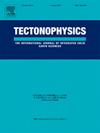How deformation shapes the Salar de Antofalla, southern Puna: Insights from a 4D kinematic-dynamic model
IF 2.7
3区 地球科学
Q2 GEOCHEMISTRY & GEOPHYSICS
引用次数: 0
Abstract
The southern Puna, characterized by salt flats, known as salars, offers key insights into how deformation during changing tectonic stress regimes influences sedimentation and basin floor subsidence in subduction-related orogens. This study focuses on the Salar de Antofalla, one of the most elongated salt flat basins in the Puna. Through structural mapping and paleostress reconstruction, we investigate the regional stress field evolution during orogeny and salar basin formation, and propose a 4D kinematic-dynamic model for the formation of the Salar de Antofalla and Salar del Fraile. Results reveal that between ∼20 and ∼ 14 Ma, the region was under a reverse faulting stress regime, followed by a transition to a strike-slip/reverse faulting regime, and eventually to a pure strike-slip faulting regime after 9 Ma. The transition from 14 to 9 Ma was marked by the activation of dextral NW-striking fault systems like the Archibarca fault, which exhibited high dilation and were linked to contemporaneous volcanic activity. From 9 to 4 Ma, the pure strike-slip faulting stress regime, characterized by E-W σ1 and N-S σ3, promoted the development of NE-striking dextral faults and the reactivation of sinistral NW-striking faults. This led to the formation of small salt flat basins, such as Salar del Fraile and Lower Juncalito, up to 4 Ma. After 4 Ma, a shift in σ1 orientation toward SW-NE facilitated the formation of the NNE-striking Salar de Antofalla fault system. The connection of dextral faults of this system played a key role in the salar's formation, with dextral movement and local transtension driving subsidence. This study suggests that the Salar de Antofalla's formation resulted from dextral fault interactions and transtensional activity rather than solely compressional or extensional forces.

形变如何塑造普纳南部的Antofalla盐湖:来自4D运动学动力学模型的见解
普纳南部以盐滩(salars)为特征,为研究构造应力变化期间的变形如何影响与俯冲有关的造山带的沉积和盆地底沉降提供了关键见解。这项研究的重点是盐湖德安托法拉,在普纳地区最细长的盐滩盆地之一。通过构造填图和古应力场重建,研究了造山和盆地形成时期的区域应力场演化,提出了Antofalla盐湖和del Fraile盐湖形成的四维运动学-动力学模型。结果表明,在~ 20 ~ ~ 14 Ma期间,该地区处于逆断层应力状态,随后过渡到走滑/逆断层状态,并在9 Ma后最终过渡到纯走滑断裂状态。从14 Ma到9 Ma的过渡,标志着像Archibarca断层这样的右旋北西向断裂系统的激活,该断裂表现出高度扩张,并与同期火山活动有关。9 ~ 4 Ma,以E-W σ1和N-S σ3为特征的纯走滑断裂应力体系,促进了北东向右行断裂的发育和北西向左行断裂的复生。这导致了小型盐滩盆地的形成,如Salar del Fraile和Lower Juncalito,一直持续到4 Ma。4 Ma以后,σ1向西-北东向转变,有利于形成北北东向的安托法拉盐湖断裂体系。该体系右旋断裂的连接对咸海的形成起了关键作用,右旋运动和局部拉张作用驱动了咸海的沉降。研究表明,该盆地的形成是由右旋断层相互作用和张拉活动共同作用的结果,而不是单纯的挤压或张拉作用。
本文章由计算机程序翻译,如有差异,请以英文原文为准。
求助全文
约1分钟内获得全文
求助全文
来源期刊

Tectonophysics
地学-地球化学与地球物理
CiteScore
4.90
自引率
6.90%
发文量
300
审稿时长
6 months
期刊介绍:
The prime focus of Tectonophysics will be high-impact original research and reviews in the fields of kinematics, structure, composition, and dynamics of the solid arth at all scales. Tectonophysics particularly encourages submission of papers based on the integration of a multitude of geophysical, geological, geochemical, geodynamic, and geotectonic methods
 求助内容:
求助内容: 应助结果提醒方式:
应助结果提醒方式:


